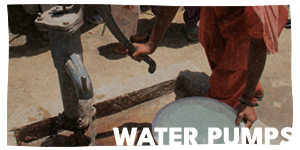
Although covering some 70% of the Earth's surface, most water is saline. Freshwater is available in almost all populated areas of the earth, although it may be expensive and the supply may not always be sustainable.
There are many methods of collecting water. The most common methods are the use of a well or the use of rainwater harvesters. When filtered, it becomes potable water which can be drunk.[1]
Sources where water may be obtained include:
- Ground sources such as groundwater, hyporheic zones and aquifers.
- Precipitation which includes rain, hail, snow, fog, etc (see rainwater harvesting) Even humid air can be used as a source for water, see Fof nets and Atmospheric water generator (the latter extracts moisture from dry desert air and filters it to pure water).
- Surface water such as rivers, streams, glaciers
- Biological sources such as plants (See Gathering water from plants) and animals (urine)
- The sea through desalination
- Water supply network
In addition, greywater (water from washing machines, sinks, showers and baths) may be reused in landscape irrigation and toilets as a method of water conservation.
Technologies[edit | edit source]
Global water usage[edit | edit source]
A major factor of sustainable living involves that which no human can live without, water. Unsustainable water usage has far reaching implications for humankind. Currently, humans use one-fourth of the earth's total water in natural circulation, and over half the accessible runoffW.[2] Additionally, population growth and water demand is ever increasing. Thus, it is necessary to use available water more efficiently.
The classic solution with minimal life-style changes for obtaining water in a autonomous house is by using a well. Once drilled, a well-foot requires substantial power. However, advanced well-foots can reduce power usage by twofold or more from older models. Well water can be contaminated in some areas. The sono arsenic filter eliminates unhealthy arsenic in well water.
However drilling a well is an uncertain activity, with aquifers depleted in some areas. It can also be expensive.
In regions with sufficient rainfall, it is often more economical to design a building to use rain, with supplementary water deliveries in a drought. Rain water makes excellent soft washwater, but needs antibacterial treatment. If used for drinking, mineral supplements or mineralization is necessary.[3]
Transporting water[edit | edit source]
In order to transport water, we have 2 options:
- Make the water run towards a lower point (called a Gravity-controlled system)[4] These typically consist of an unpressurized water tank at an elevation higher than the point of use. Pressure at the point of use is the result of the hydrostatic pressure caused by the elevation difference.
- Increase the water pressure. This is typically done using a pressure vessel.[5] Alternatively, a Inline pump controller or pressure-sensitive pump may be used.[6]
References[edit | edit source]
- ↑ Graywater Reuse and Rainwater Harvesting. Colorado State University Extension. Web. 27 Oct. 2010.
- ↑ Hawken, Paul, Amory Lovins, and L. Hunter Lovins. Natural Capitalism: Creating the Next Industrial Revolution. New York City: Little, Brown and Company, 1999. Print.
- ↑ WHO | Nutrient minerals in drinking-water and the potential health consequences of consumption of demineralized and remineralized and altered mineral content drinking-water: Consensus of the meeting
- ↑ Pushard, Doug (2005). "Domestic water collection systems also sometimes able to function on gravity". Harvesth2o.com. Retrieved 2009-04-17.Template:Verify source
- ↑ Pressure vessel schematics
- ↑ Pushard, Doug. "Alternatives to pressure vessels in domestic water systems". Harvesth2o.com. Retrieved 2009-04-17.
See also[edit | edit source]
- Sewage system: most systems (in the developed world) use a combined sewage/potable water system
- LEED


